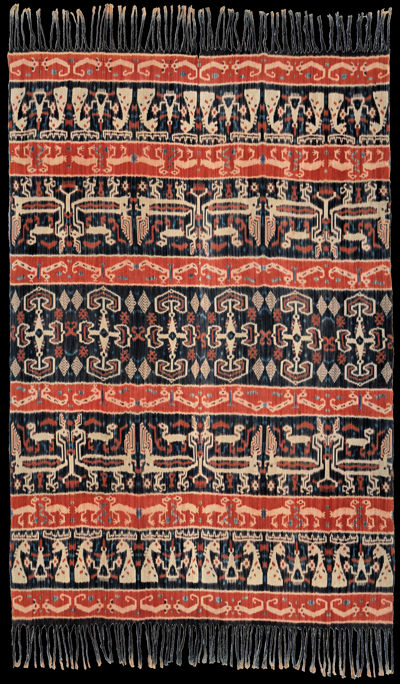| |
 
 | | | |
355 Sumba, East Sumba
Hinggi (men's blanket)  
| | Locale: | Kambera, probably | | Period: | Early 20th c. | | Yarn: | Cotton, hand-spun, very fine, double-ply | | Technique: | Warp ikat | | Panels: | 2 | | Size: | 151 x 240 cm (4' 11" x 7' 10") LW: 1.59 | | Weight: | 800 g (28.2 oz), 221 g/m2 (0.72 oz/ft2) | | Design: | Hinggi with asymmetric centrefield. Hidden visual devices break the traditional axial symmetry. It was constructed with 6-fold, rather than the standard 8-fold replication in the constituent panels. Panel reversal, sambung terbalik, emphasizes the asymmetry - see the odd motif where the axis crosses the seam. This hinggi has the classic eleven band field division which faded out of fashion after 1920. The motifs in the wide ikated bands closest to the extremities are stag heads, a rare design. The birds are versions, again rare, of chickens that were given the heads of cockatoos - a royal motif. The midfield is decorated with habaku motifs, also reserved for royalty. | | Background: | Chapters on Sumba and East Sumba. | | Published: | Ikat from Timor and its Outer Islands, 2022.
Noble Virtuosity: Hidden Asymmetry in Ikat from Sumba, 2024. | | Sources: | One of the few examples of the stag head motif is a richly decorated hinggi with large dragons in the Museum Rietberg, inv. nr. RIN 1402, dated circa 1900 - which is perhaps a little early given its nine band design, which appears to have come en vogue around 1920, its main advantage being that it allows the creation of very large motifs in the endfields. Information on motifs provided by Kinga Lauren. | | |

©Peter ten Hoopen, 2025
All rights reserved.
|
|


